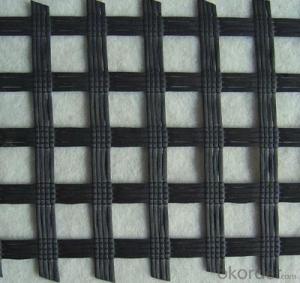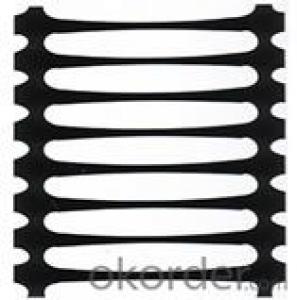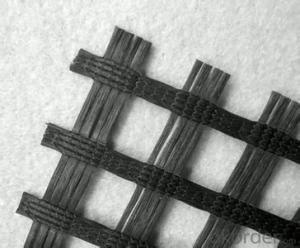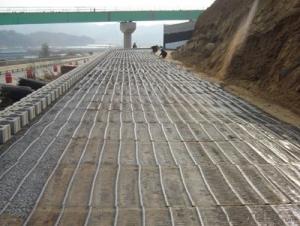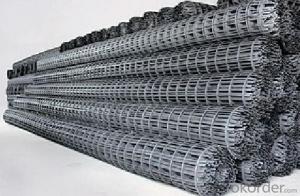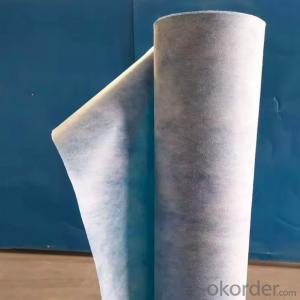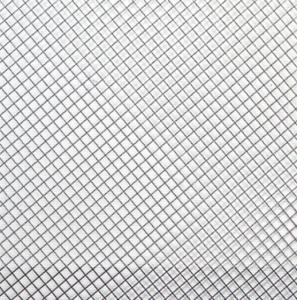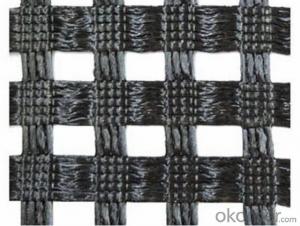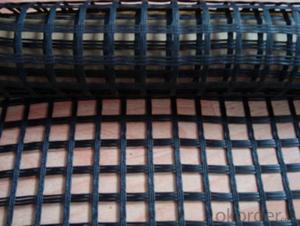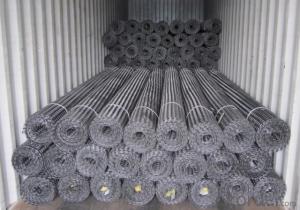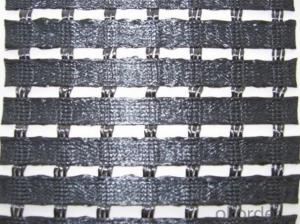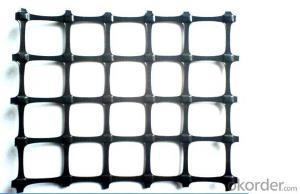Woven & Knitted Biaxial Plastics Geogrid BX1200 BX1100
- Loading Port:
- Qingdao
- Payment Terms:
- TT OR LC
- Min Order Qty:
- 1000 m
- Supply Capability:
- 50000 m/month
OKorder Service Pledge
OKorder Financial Service
You Might Also Like
Type:
1) Woven & knitted: use various fiber types (e.g. monofilament, multi-filament, split extruded film) in different combinations.
2)Non-woven: staple or continuous fiber that are heat treated or needle punched to “fix” fiber relative to each other.
Functions:
Major functions: Separation, filtration, drainage, reinforcement, protection, and liquid barrier
1) Filtration
The filtration layer of the dykes, river canal, seacoast, concrete slope, retaining walls. At the same time of preventing the clay granule from passing, it allows the water and the gas pass through freely.
2) Separation
The isolation of the railway dregs and the roadbed, roadbed and the soft base, surface of the airdrome and parking lot and the groundsill, different dam materials. It isolates the soil and the gravel of two kinds of different granule pathway from the groundsill or other buildings.
3 )Adding muscle:
The highway, railway, soil-stone dam, breakwater, airport, backfill soil of retaining wall, slope protection, etc in which distributes the earth stress, prevents the side-displacement of the earth body and improves the earth body stability.
4 )Protection
It prevents the bank from being washed out, protects the bank and the bottom, prevents the water and soil from being washed away.
Specigication:
Quality per unit area(g/m2) | 120g | 160g | 200g | 240g | 280g | 340g | 400g |
After the breaking strength(KN/m)≥ | 20 | 30 | 40 | 50 | 60 | 80 | 100 |
Zonal breaking strength(KN/m)≥ | 15 | 22 | 28 | 35 | 42 | 56 | 70 |
Latitude and longitude to the elongation at break(%)≤ | 25 | ||||||
Trapezoidal tear strength (longitudinal)(KN)≥ | 0.2 | 0.27 | 0.34 | 0.41 | 0.48 | 0.6 | 0.72 |
Bursting Strength(KN)≥ | 1.6 | 2.4 | 3.2 | 4.0 | 4.8 | 6.0 | 7. |
Vertical permeability coefficient(cs/m) | 10-1~10-4 | ||||||
Equivalent aperture(O95mm) | 0.07-0.5 | ||||||
Deviation permit(%) | ±10 | ||||||
- Q:How do geogrids improve the performance of soil retaining structures?
- Geogrids improve the performance of soil retaining structures by providing reinforcement and stability to the soil. They increase the tensile strength of the soil, preventing it from sliding or collapsing under heavy loads or external forces. Additionally, geogrids enhance the overall durability and longevity of the retaining structures by reducing soil erosion and improving drainage.
- Q:Are geogrids resistant to seismic forces?
- Yes, geogrids are designed to be resistant to seismic forces. They are made from durable materials that can withstand the dynamic forces generated during an earthquake, providing stability and reinforcement to soil and structures. Geogrids help distribute seismic forces and prevent soil liquefaction, making them a reliable solution in areas prone to earthquakes.
- Q:What are the design considerations for geogrid-reinforced embankments?
- Some key design considerations for geogrid-reinforced embankments include the selection of appropriate geogrid material, determining the required strength and stiffness of the geogrid, considering the effects of construction and installation techniques on the performance of the reinforcement, assessing the soil properties and slope stability of the embankment, and ensuring proper connection and interaction between the geogrid and the embankment materials. Additionally, factors such as long-term durability, potential for differential settlement, and environmental considerations should also be taken into account during the design process.
- Q:What is the recommended depth of geogrid installation?
- The recommended depth of geogrid installation can vary depending on the specific project and soil conditions. However, in general, it is recommended to install geogrids at a depth of at least 12 inches to provide adequate stabilization and reinforcement to the soil.
- Q:Evaluation criteria and technical disclosure of geogrid.. Know how to share. Thank you
- 3) fill: after the completion of the grille, should be timely (48 hours) filling. Each layer should be carried out according to the principle of "the first two sides, the middle of the back". The packing is not allowed to be unloaded directly on the geogrid. It must be unloaded on the soil surface which has been paved. The soil unloading height is not more than 1m. All vehicles and construction machinery shall not be allowed to walk directly on the paved geogrid, but only to be allowed to travel along the axis of the embankment.4) the upper and lower sides of the geogrid, and 8 cm from the grid layer shall not be more than 6 cm in diameter
- Q:Are geogrids resistant to chemical leaching?
- Yes, geogrids are generally resistant to chemical leaching. They are designed to withstand exposure to various chemical substances without significant degradation or leaching, making them suitable for applications where chemical resistance is required.
- Q:Can geogrids be used in reinforcement of underground stormwater detention systems?
- Yes, geogrids can be used in the reinforcement of underground stormwater detention systems. Geogrids are commonly used in such systems to provide additional support and stability to the underground structures, helping to prevent soil erosion and maintain the integrity of the detention system.
- Q:What is the cost of geogrid installation?
- The cost of geogrid installation can vary depending on various factors such as the size of the project, the type and quality of geogrid being used, location, and labor costs. It is best to consult with a professional contractor or supplier to get an accurate estimate for your specific installation needs.
- Q:The ground treatment is full of geogrid is not along the line direction
- Generally paved along the direction of the road
- Q:Plastic two-way geogrid hole 4 cm thick, 1 mm wire width of 4 mm
- So I can give you a good price
1. Manufacturer Overview |
|
|---|---|
| Location | |
| Year Established | |
| Annual Output Value | |
| Main Markets | |
| Company Certifications | |
2. Manufacturer Certificates |
|
|---|---|
| a) Certification Name | |
| Range | |
| Reference | |
| Validity Period | |
3. Manufacturer Capability |
|
|---|---|
| a)Trade Capacity | |
| Nearest Port | |
| Export Percentage | |
| No.of Employees in Trade Department | |
| Language Spoken: | |
| b)Factory Information | |
| Factory Size: | |
| No. of Production Lines | |
| Contract Manufacturing | |
| Product Price Range | |
Send your message to us
Woven & Knitted Biaxial Plastics Geogrid BX1200 BX1100
- Loading Port:
- Qingdao
- Payment Terms:
- TT OR LC
- Min Order Qty:
- 1000 m
- Supply Capability:
- 50000 m/month
OKorder Service Pledge
OKorder Financial Service
Similar products
New products
Hot products
Hot Searches
Related keywords
